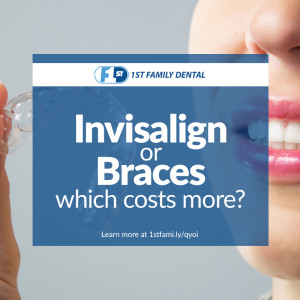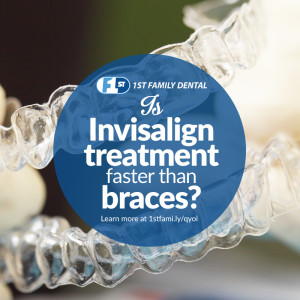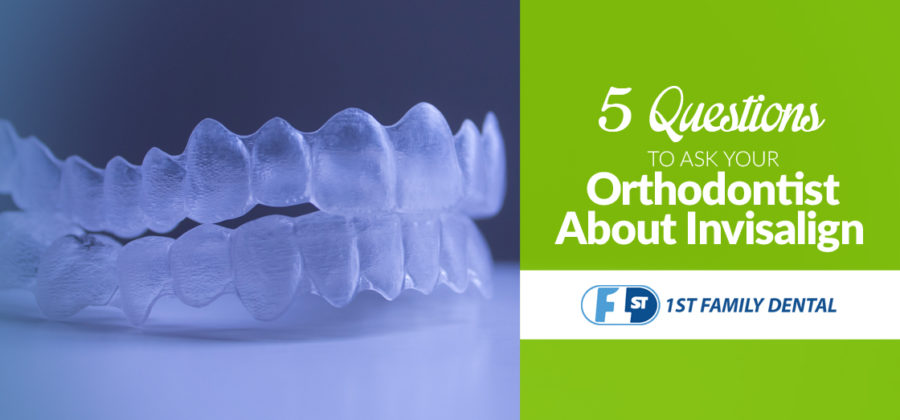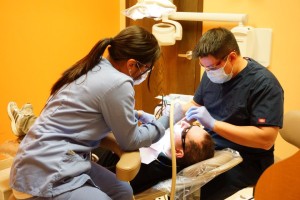Considering Invisalign to straighten and align your teeth? As Invisalign grows in popularity, so do the number of questions we receive from interested patients which is why we’ve put together a short list of important questions to ask your orthodontist about Invisalign.
 Not long ago, we here at 1st Family Dental went on the record with our position that perfectly straight teeth are not necessary for great oral health. What’s most important, in our opinion, is to have teeth that are properly aligned, so that they can be as healthy as possible, and help you to live a healthy life as well.
Not long ago, we here at 1st Family Dental went on the record with our position that perfectly straight teeth are not necessary for great oral health. What’s most important, in our opinion, is to have teeth that are properly aligned, so that they can be as healthy as possible, and help you to live a healthy life as well.
Some signs that teeth may not be properly aligned can include jaw pain, over or underbite, protrusion or crowding (overlapping) of teeth, extra or uneven spaces between teeth, and difficulty with brushing or flossing which can lead to cavities and even gum disease. Orthodontic treatment is often recommended to correct these issues to help achieve optimal oral health.
One such option is Invisalign treatment. Many folks think that Invisalign is a “cosmetic” treatment option, as compared to traditional braces. However, Invisalign can be a great option to correct quite a few orthodontic issues, while remaining largely invisible to most people.
Traditional braces do not have to be a rite of passage for adults or kids. If you think you or a loved one may need orthodontic treatment, and would like to consider your options, we suggest reviewing this helpful comparison between traditional braces and Invisalign below.
5 Questions to Ask Your Orthodontist About Invisalign
Are you thinking about seeing an orthodontist to see if you may need orthodontic treatment, and to explore your options, including Invisalign? We have a list of questions that can help you to get the most out of that visit, no matter who you choose to see. We list these questions to ask your orthodontist about Invisalign because our dental and orthodontic patients have asked these same questions.
What orthodontic issues can Invisalign correct?
Invisalign can correct many of the same issues as traditional braces, but not all, and the amount of correction needed can also play a role. Traditional brackets and wires or even appliances such as headgear may be needed to move teeth and align the jaw properly. In other cases, Invisalign aligners may do a fine job to correct the issue.
 How long can treatment last for my particular case, and is there any way to accelerate it?
How long can treatment last for my particular case, and is there any way to accelerate it?
The average length of treatment for both traditional braces and Invisalign is often similar, but many factors can influence this, including age, the amount of correction and realignment needed, and generally how quickly that type of issue can be corrected. Both traditional braces and Invisalign require regular visits for either adjustments or to receive new aligner trays. Keeping up with those visits is necessary to achieve results. AcceleDent technology is also available for some patients to help increase the speed of teeth movement and improve results.
Will Invisalign still work if I am an adult/older?
Many adults are choosing to get their smiles into alignment – in fact, nearly one quarter of our orthodontic patients are adults! While traditional braces are becoming more accepted for both adults and kids, Invisalign is a great option for adults who may not want the full “braces” experience, and would prefer a lower-profile, nearly invisible option.
Why is the up-front cost of Invisalign more than traditional braces?
Invisalign uses a series of clear aligner trays, based on impressions taken from your mouth. These trays are custom crafted for you in a laboratory, which is why the up-front cost of invisalign is more than traditional braces. At 1st Family Dental, your Invisalign case will be supervised by an orthodontist, but it is important to note that having such a high level of training and experience is only a bonus and does not impact the cost of your Invisalign treatment.
My teeth don’t LOOK crooked to me
Why is my dentist recommending an orthodontic consult? Appearance is not the only factor involved in the proper alignment of teeth. Your teeth and jaw are a combination-team. While your front teeth may appear straight, your back teeth may not be touching and aligning properly. This can affect your overall oral health and, left untreated, can also eventually affect other teeth. A quick, 15-minute consultation with an orthodontist can help you weigh the pros and cons of treatment, including Invisalign.
BONUS: DIY Teeth Straightening? If that guy did it himself, why shouldn’t I?
You may have read by now about the college student who used a 3D printer to make his own teeth aligners – and it looks like it may have worked. While he did a great job and studied tooth movement carefully, his case was very minor, and it shouldn’t be expected that everyone would have the same result, even if they followed the same steps. We also should note that this student had access to a 3D printer, which itself can cost thousands of dollars.
Teeth and jaw alignment is a complex process and we advise taking advantage of the best in training and technology to accomplish the results you desire.
Join Us in the Comments!
Considering Invisalign? Ask your questions in the comments section!
Leave a comment







11 Comments
Leave your reply.